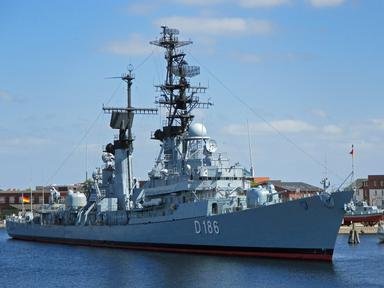Quiz Answer Key and Fun Facts
1. The Washington Naval Treaty of 1922 was the first time that the world's leading naval powers agreed to limit the size and armament of warships, including cruisers. A class of British cruisers, built between 1916 and 1925, was the standard used for the designation of "heavy cruiser". What was the name of this class?
2. What was the class name for the largest group of heavy cruisers built by Great Britain? Eleven were completed for the Royal Navy, and two for the Royal Australian Navy.
3. What was the name of the first heavy cruiser built for the U.S. Navy?
4. Though not a party to either the Washington or London Naval Treaties, the Soviet Union built a class of six ships between 1938 and 1944 that were considered heavy cruisers. What was the class name of these vessels?
5. The second class of American heavy cruisers numbered six ships, three of which survived World War II. Can you name the lead ship of this class?
6. What was the name of the only heavy cruiser class built for a South American navy?
7. The French and Italian navies were rivals in the Mediterranean, and were constantly trying to out-build one another in the interwar years. What was the name of the first class of French heavy cruisers?
8. The second class of French heavy cruisers were the Suffren class, comprising the Suffren, Colbert, Foch, and Dupleix. How many of these ships survived World War II?
9. What was the name of the first class of Italian heavy cruisers?
10. The second class of heavy cruisers built by Italy, the Zara class, had the unfortunate distinction of having three of the four ships in the class sunk in the same battle. What was the name of the battle in which the Zara, Pola, and Fiume all went down?
11. Germany, like the Soviet Union, was not party to the Washington or London Naval Treaties. The Germans built a class of heavy cruisers that were some of the largest of the type ever built. What was the name of this class?
12. Japan's first two classes of heavy cruisers, the Furutaka and Aoba classes, displaced 7,100 tons and were armed with six 7.9-inch guns, though these were later replaced with nine 8 inch guns in the Furutakas and six 8-inchers in the Aobas. Of the four ships completed, how many survived World War II?
13. The next class of heavy cruisers built for Japan, the Myoko class, were the first Japanese ships to exceed the treaty limits on weight. Armed with ten 7.9-inch guns, what was the displacement for the Myokos?
14. The third and fourth classes of American heavy cruisers, the Portland and New Orleans classes, were close copies of each other and were built at almost the same time, 1930-1932 for the Portlands and 1930-1934 for the New Orleans class. Which class lost three ships in the same battle?
15. What was the name of the last U. S. heavy cruiser designed to conform to the London Naval Treaty limits? This ship was the only vessel in her class.
16. What was the name of the first class of US heavy cruisers built after World War II began, which were also the most numerous class built for any navy?
17. After the Baltimores, the next class of US heavy cruisers were modified to improve their fire control. Three units were built, but were too late to see service in World War II. What was the class name of these vessels?
18. The fourth class of Japanese heavy cruisers were virtual repeats of the Myoko class, displacing 11,350 tons and armed with ten 7.9-inch guns. Name the lead ship.
19. Which class of Japanese cruisers were completed as light cruisers, armed with 6-inch guns, but were later converted to heavy cruisers?
20. Spain, another country not bound by either the Washington or London treaties, built two heavy cruisers, the Canarias and Baleares, which were nominally within treaty limits. Which other naval power assisted the Spanish Navy with their construction?
21. What was the name of the last heavy cruiser class built for the British Royal Navy?
22. What was the name of the last heavy cruiser built for the French Navy?
23. What was the last heavy cruiser completed by the Italian navy?
24. What is the class name of the last heavy cruisers built by the Japanese navy?
25. The Des Moines class were the last heavy cruisers built by the U.S. Navy, as well as the last such ships built by any navy in the world. How many ships in the class were completed?
Source: Author
Reamar42
This quiz was reviewed by FunTrivia editor
stedman before going online.
Any errors found in FunTrivia content are routinely corrected through our feedback system.
